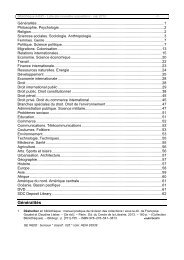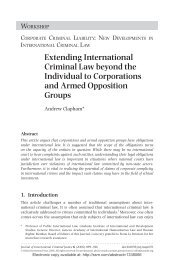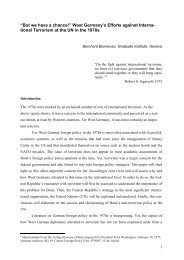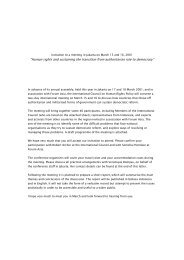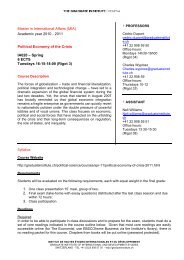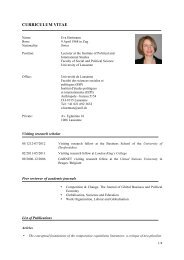Download [pdf] - The Graduate Institute, Geneva
Download [pdf] - The Graduate Institute, Geneva
Download [pdf] - The Graduate Institute, Geneva
Create successful ePaper yourself
Turn your PDF publications into a flip-book with our unique Google optimized e-Paper software.
Pascal Lamy at the Opening of the Academic Year of the <strong>Graduate</strong> <strong>Institute</strong> at the World Trade Organization on 3 October 2012. Photo Eric ROSET.<br />
Do you view the “mega-regionals”,<br />
like TPP and TAP, as posing<br />
a different challenge to the WTO<br />
than the many bilateral RTAs<br />
since 1990s?<br />
At one level no and at another level<br />
yes. We have had mega-regionals<br />
before. <strong>The</strong> joining of Europe into a<br />
Single Market created the largest trading<br />
power in the world. NAFTA is an<br />
enormous trading area. ASEAN, APEC,<br />
all of these trading entities are big. <strong>The</strong><br />
WTO, and the GATT before it, continued<br />
to operate successfully. In fact,<br />
many of these preferential trading<br />
arrangements affect trade far less than<br />
you might imagine. We at the WTO<br />
have studied this situation closely and<br />
we have determined that around 85%<br />
of trade today takes place under MFN<br />
or WTO tariffs. Only about one-third<br />
of peak tariffs (15% or higher) are eligible<br />
for reduction under preferential<br />
trade arrangements. Moreover, businesses<br />
often are confused about the<br />
multitude of rules of origin, tariff structures,<br />
customs requirements that are<br />
part and parcel of such bilateral agreements.<br />
This is why only around onequarter<br />
of businesses surveyed in Latin<br />
America and Asia actually trade under<br />
the terms of bilateral agreements. <strong>The</strong><br />
risk is a proliferation of different standards<br />
or regulations, which are less<br />
transparent than duties. While such<br />
measures are normally drafted to<br />
address real problems, they can inadvertently<br />
or otherwise, lead to trade<br />
slowing down and/or rising trade tensions.<br />
<strong>The</strong>se kinds of agreements are<br />
politically cheaper, but economically<br />
lower quality.<br />
And we should not underestimate the<br />
danger of competing – or even conflicting<br />
– trading blocks. When such trading<br />
arrangements are superimposed<br />
over a paradigm of rising geopolitical<br />
tension and rivalry, the danger grows.<br />
How this situation evolves depends<br />
on a number of factors including the<br />
true objectives behind entering into<br />
these relationships. If the objective<br />
is opening trade, there can be benefits,<br />
but this depends on how such an<br />
opening takes place and what strings<br />
are attached. If we are to avert this,<br />
we need to “multilateralise” regionalism<br />
through enhanced global rules<br />
and market opening. •<br />
LA REVUE DE L’INSTITUT I THE GRADUATE INSTITUTE REVIEW I GLOBE I N11 Printemps I Spring 2013<br />
11


![Download [pdf] - The Graduate Institute, Geneva](https://img.yumpu.com/23370020/12/500x640/download-pdf-the-graduate-institute-geneva.jpg)
